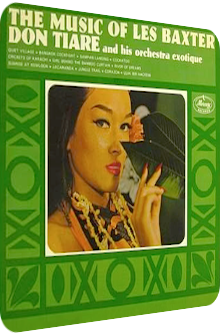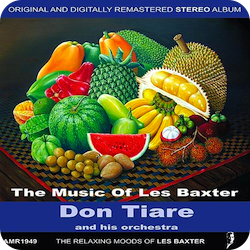
Don Tiare
The Music Of Les Baxter
1963
“A merger of the talents of two geniuses of the sensuous and the exotic,” the liner notes boldly state, and yes, I do agree with this averment. Enter The Music Of Les Baxter, released in 1963 on Mercury Records and envisioned by Exotica oddball Don Tiare about whom next to nothing is known. I would love to see him rise in fame – after all, it has happened posthumously to Gene Rains as well – and enjoy digital reissues of his albums. The time is indeed nigh. Don Tiare is an arranger of string-heavy albums such as Strings Over Hawaii and Strings Over Tahiti (both released in 1963), but on The Music Of Les Baxter, he not only shows his skills in leading a quintessential quintet called the Orchestra Exotique, he also reveals his connections to one of Hollywood’s greatest composers of all times, said Les Baxter (1922–1996).
Not only did Don Tiare get permission to mould Baxter’s orchestral works into the combo sound à la Martin Denny, no, Les Baxter comes up with four pieces that were either specifically written with this project in mind, or taken from his archives of sheet music and handed over to Don Tiare! The result is the same: it is new material, never heard before in this particular way. In addition, the album also features material from African Jazz and Jungle Jazz (both released in 1959) as well as The Soul Of The Drums (1963), of course yet again in a transformed physiognomy full of gentle pianos, vibraphones aplenty and Latin percussion. The liner notes state that “Baxter paints pictures with sound,” whereas “Don Tiare gives us the three-dimensional ‘sight’ to hear them with.” Is this the whole secret to the album’s success? No, as I find this specific sentence a bit too Tiare-centric, to be honest. I carve out further thoughts below, play the oracle for a moment and even give a cunning prognosis at the end.
 The digital reissue sports a fruit basket. That's what Les Baxter's music is all about!
The digital reissue sports a fruit basket. That's what Les Baxter's music is all about!
The famous Cha Cha Cha groove of Quiet Village opens the disc, and there is no other opener to justify the stardom Les Baxter enjoys in the realms of Exotica. Don Tiare takes Baxter’s symphonic vision and places it much nearer the – some might say archetypical – quartet sound of the day. The raspy guiro is particularly piercing, the piano aquiver with pleasure, ligneous bongos conflate with moist vibes. The middle section sees triangles and other plinking devices unfold in the scenery. A good but by no means stellar rendition for one reason: as odd this may seem, but the percussion plays too much upfront and outshines the very dreaminess which should be in the spotlight.
The same tendency is noticeable in the next classic, the vivacious Bangkok Cockfight, but here the clinging iridescence works better due to the bustling scenery and uptempo frenzy. The piano chords are gorgeous, their vibe helixes soothing, and the different drum textures a delight. Even short marimba protrusions find their way into the setting. Bangkok Cockfight can usually be interpreted by means of stressing the mania and lunatic ballup, but Don Tiare decides to rev up the euphony while still retaining the energy level and therefore finds a great balance between the counteracting forces.
Up next is Sampan Landing, a tune Baxter wrote specifically for this album. Consequentially, there does not exist an orchestral version to compare it to. Various Baxterisms are nonetheless all over this piece, be it the amalgamation of darkly droning piano tones and their mercurial-monolithic sunset-colored next of kin, the overall insouciance or that cinematic angle. Don Tiare uses two particularly great tricks to bring this piece to life by firstly creating ever-changing chaparrals of hissing percussion and by ennobling some of the vibraphone tones with a rotatory fluttering afterglow. Crickets Of Karachi then showcases another previously unheard Baxter finger exercise, one which is first interpreted here by Don Tiare, but then enjoyed the respect of one other luminary named Arthur Lyman later on. Crickets Of Karachi offers an eminently exotic simultaneity of Occidental fairy tale timbres and the infinitesimally off-key polyphony of the Orient on both the xylophone and vibraphone, held together by a middle section of majestic guitar chords. Shuttling between comicality and distantly murky undertones, these crickets sound truly unique, and once you hear the textures, you will not forget them.
The final two pieces of side A have both been included on Baxter’s 1963 LP The Soul Of The Drums just a few months prior to Don Tiare’s album: while the jazzy Girl Behind The Bamboo Curtain sports hectic rhythm pianos, a thicket full of bongos and wood sticks and quirky vibraphone flecks, River Of Dreams offers the composer’s superior mood, namely a soothing downbeat piece charged with lacunar structures, laid-back bongo rhythms and golden shimmering piano chords of pure bliss. This is indeed dreamy Exotica par excellence.
Side B opens with the mighty Cockatoo, taken off the brass-heavy Jungle Jazz (1959) and envisioned here in a completely horn-less way, with chiming vibes, a few classic drum kit ingredients such as cymbals next to a galloping beat and warm globs of a partially cheeky piano aorta. Another bunch of tracks taken from The Soul Of The Drums follows: Sunrise At Kowloon sees its solemn tempo increased and augmented with sprinkling maracas, a particularly voluminous vibrance of the piano and yellow-tinged vibraphone sparks which seem to reflect the sunlight of the peninsula’s ponds and waters, whereas Jacaranda comprises of rhythm pianos and a particularly pointillistic, albeit humpy amicability with that tropical carefreeness. The vibes almost resemble cowbells here, their vitreous characteristics are the definite highlight of this interpretation.
Jacaranda leads to Jungle Trail, a piece of sheet music particularly written for Don Tiare’s album. It is much more minimal, but in a good way, putting the piano into the limelight, reducing the centroid nature of the vibraphone in this triad which is rounded off by delicate bongos and maraca strata. Uplifting and moving forward, Corazon is reached, another unique destination with a jazzy jumpiness on the piano and a rather eclectic interplay between the chords as well as a more soothing vibraphone solo; both ingredients are again held together by that Latin spirit. The utterly comical Quai Bir Hackheim is the tipsy finale, with a fairground-like Honky Tonk atmosphere of laissez-faire tonalities coated in slight tinges of madness. An exotic travesty which is both de trop… and tropical.
Let me play the role of the spoilsport here (it is really only a role!): The Music Of Les Baxter is a seemingly unnecessary Exotica artifact. The composer's music statistically appears on every second genre album, and once it does not, it is probably because the composer, artist or combo decides to present unique material and nothing else. So does The Music Of Les Baxter stand a chance in this ever-growing market? You know the answer, but here it comes anyway: yes, this is a splendid and even essential LP, if only for the fact that four unique songs from Les Baxter’ feather are on board, ones from the archives which were not often considered, probably due to the smaller aura of Don Tiare and the Mercury Label in general. But here the synergetic effect works really well.
Exotica fans who love that Latin quartet sound with the crawing guiros and vesiculating bongos should be more than pleased, for Don Tiare is able to sum up a smaller band that stands in contrast to his otherwise string-heavy works. It is Quiet Village of all things that is a letdown in this context due to the overly frilly and incisive percussion layers, but the remaining material shines and benefits from freshness and vigor. Tunes like Sampan Landing or the Latinistic Corazon were never heard before – or ever since – and contain that enlightening paradisal feeling Les Baxter is known for. It remains strange to me how one Don Tiare who has yet to make it to the hearts of Exotica fans is able to access the treasure trove of one of Exotica’s very greatest composers, but believe it or not, this album is for real… and has even been digitally reissued by Sinetone AMR! There is no reason to not check out this gemstone. Chances are that the quality will blow you away severely. It could well be that this is the next album amid Exotica fans that is hailed as a magnificent emerald that remained under the radar for the wrong reasons. I hope it skyrockets, for it is splendid.
Exotica Review 334: Don Tiare – The Music Of Les Baxter (1963). Originally published on Apr. 19, 2014 at AmbientExotica.com.
